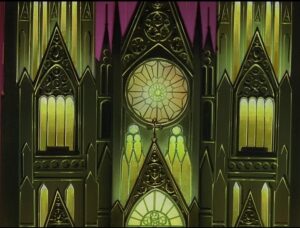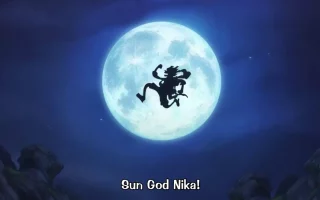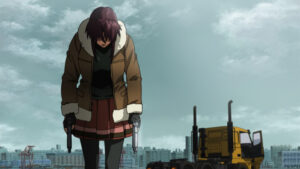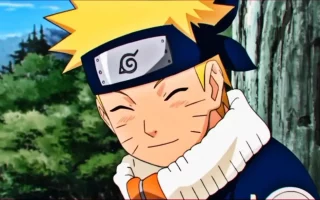In the 90’s there aired a now legendary TV show called Batman: The Animated Series. With its combination of film noir and art deco visual styles, it basically defined what Batman would look and sound like for decades to come. I bring this up because working on said legendary show was a little known studio you might have heard of by the name of Sunrise. They, with Kazuyoshi Katayama as Director and Chiaki Konaka of Serial Experiments Lain and Texhnolyze fame as Series Composition, would go on to create the cult classic mecha anime we are here to talk about today: The Big O. What would happen if you gave Bruce Wayne a giant robot? Or if Robin was a female android with a skill for witticisms? All animated by the studio known for their giant robots and written by a man with a penchant for… The weird. Lets dive in and find out.
Be warned, this review covers both seasons of The Big O and contains minor unmarked spoilers for both. It also contains major spoilers in some sections however these will be heavily marked to avoid accidents.
Visuals
Lets begin with the series production. Big O’s is interesting, in that it sits right on the interstice of two different eras of animation. Season one, created in 1999, was created in the final years of cel animation. That means more detailed, but also more limited, animation as well as less color saturation. Meanwhile season two, created in 2003, was done digitally. This loses some of the character or individuality of each frame but is also a cheaper and more efficient animation pipeline. That said, because of Big O’s use of thick lines, heavy blacks and simple colors, all due to its Noir and Art Deco inspirations, it manages to avoid many of the worst pitfalls of this switch. You’ll definitely notice the change, but its end up being largely positive, bringing a great deal more movement and expression to the characters while losing little in the way of visual style.
However for all that the animation changes, the style and quality of the direction remains consistent between the two seasons. Kazuyoshi Katayama and his team go to great lengths to establish Paradigm City, the primary setting of Big O, as a character unto itself, much like its inspiration Gotham City which is, in turn, inspired by New York City. Through a great number of wide establishing shots, you’ll get a feel for the city and come to recognize a number of locations and domes just by their color palette or the design of the architecture. This isn’t to say Big O is perfect, it often operates on Game of Thrones time where characters can travel between two locations, ostensibly on the opposite sides of the city, very quickly. Still, this doesn’t hurt much as time is rarely an important factor.
Now this far in you might be wondering about the robots and how they fare, I mentioned this is a mecha anime after all. Well I’m pleased to report Big O does quite well! There’s a weight to Big O’s mechs. They tend to move slowly and with purpose, each step shaking the ground beneath them, really driving home that these are indeed 10 story tall slabs of steel. Even when one flies, and they rarely do, their turns are wide and they are more akin to a 737 than a Jet. This is also reflected in the environment around them, which is routinely destroyed in their conflicts. When they get hit, they stumble. When they fall, things break. They feel, look and move as if they are part of this world, never feeling out of place. The worst thing I can say is that some fights can be rather dull, a consequence of the Monster-Of-The-Week format.
Overall I would say The Big O looks solid. In fact it reminds me of Batman: The Animated Series in ways other than the obvious. It’s not the most animated of shows, instead making use of its strong art style and direction to keep you visually engaged. Detailed backgrounds and beautiful vistas. The kind of things that make you feel Gotham/Paradigm City is a real place. But when it does decide it wants to move, it goes all out. Buildings break, explosions flare and you can feel the impact of giant fists meeting steel faces. If mecha action is what you’re looking for, Big O certainly delivers. It even has a giant “Piss off” laser at one point, and who doesn’t love those?
Narrative
With that, lets talk about what Big O is actually doing with all of those giant robots and beautiful backgrounds. Big O takes place in the Paradigm City, where all of the residents have lost the memories after an event 40 years ago. Occasionally however, memories may re-awaken, and they may be something as innocuous as who your family was to the knowledge of how to build a giant robot. This is where Roger, our protagonist and the Negotiator of Paradigm City, comes in to solve problems and protect the citizens of this last bastion of humanity. Big O’s general structure is that of a classic monster-of-the-week, where each episode sees Roger solving a new problem that inevitably escalates into fight where he has to bust out eponymous “Big O”, the giant robot for which the show was named.
As you would expect, this means that the quality of each episode varies greatly, at least early on. Some will be beautiful one-off explorations of an android learning what it means to carry on a legacy, or of a twisted madman with memories of terrible atrocities seeking to repeat them once more. Others won’t feel like they fit at all however, either being irrelevant to the larger story of the city or simply being forgettable and poorly done. The latter are a rarity luckily, most of Big O’s episodic stories trend towards being at least “good”. But you will run into at least one episode that feels out of place. On top of that, while the weekly robot fights are decently varied in design and abilities, there are a few that felt more like afterthoughts in an episode that otherwise didn’t need a weekly giant robot fight.
The real strength of the series however is in how these weekly monster fights eventually coalesce into a larger singular story. One about self-determinism, memories, and what exactly defines you as you. Characters return, the memories each discovered become relevant again as the main villain hunts for one in particular, and the history of Paradigm City comes to the forefront. Admittedly, it does get rather meta by the end. And while that shouldn’t come as a surprise with Chiaki Konaka in the writers chair, it may turn some people off. Personally it took me a while before I came to like it. But like it I do, because one way or another Big O certainly earns its ending. It doesn’t come from out of nowhere, instead building on ideas and plot points introduced as early as episode one. What I’m trying to say is, Big O was always about that stuff if you know where to look for it. It just eased you into it is all.
All in all I would say that Big O’s narrative makes comes together for a strong and meaningful, if out there, ending. It’s slow in some places, clearly wanted more time in others, but I enjoyed it for most of its run. For all that it’s a monster-of-the-week giant robot show, characters reappear with alarming frequency, both heroes and villains, and many of them get multiple episodes focused specifically on them. Meanwhile our heroes, Roger and Dorothy, get more and more proactive as the story continues, giving us this feeling of progress even when doing something totally unrelated. Most important of all though, more than anything else I’ve said: Big O has an actual ending. No cliffhanger, no “See you next season” and it never comes, a real honest to God ending. You may not like it, it may not be your thing, but its there. And that’s good.
Characters
Speaking of characters, lets talk about them! Big O’s core cast consists of Roger, our leading man, Dorothy, his android side kick and live-in maid, Norman, his butler/Alfred replacement, and Angel, the Femme Fatale love interest, not to mention a rogues gallery of repeating villains. For the most part, this core cast is solid. Roger and Dorothy get most of the attention by far, their relationship being central to many episodes. Watching them grow from mere acquaintances, as Roger figures out what he wants from life and Dorothy what it means to be human, was fantastic. Easily a highlight of the show. Angel gets similar attention, though instead of progressing and improving I’d say she has more of a… decline so to speak, which is still engaging to watch. The only core member who doesn’t get some sort of arc is Norman, who is really just there for most of Big O’s run time.
Of the aforementioned villains, Big O has a number of them. Most only appear once or twice in one-off episodes, but of the repeats there are three really worth talking about: Beck, Schwarzwald and Alex Rosewater. Beck is easily the funnest villain in the roster, with some of the most charismatic lines and wackiest plans. He doesn’t have lot of narrative weight, mostly representing the “petty crime” side of things, but he’s always a joy on screen. Meanwhile Schwarzwald and Rosewater are Big O’s more “serious” villains, being based on The Joker and Lex Luthor respectively. They both challenge Roger in different ways, whether it be his understanding of the world and his place in it or by causing him to doubt his own autonomy.
As for side characters, this is where Big O starts to slip a bit. Most of these are one-off, existing for whatever story that episode wants to tell. As such, they tend to be less “Characters” and more “caricatures”. They are stand-ins for larger ideas, whether that be the poor, the religious, or the well-meaning but flawed scientist. About the only side character really worth talking about is Dastun, the police chief and a former friend of Rogers. Dastun gets a fair amount of focus, even a few episodes about him. Overall though, he’s the only “major” character who I felt didn’t get a proper “end” to his story. This is a shame because early on his relationship with Roger, both their past working together as well as his inability to meaningfully contribute to these giant robot fights, is very compelling! By the end though, he fails to do much.
To sum it up, Big O has a pretty well rounded cast of decent size, with interesting characters among both the heroes and the villains. Some, such as Rosewater, take time before they become interesting while others, such as Dorothy (My wife) and Schwarzwald (Not my wife), remain at the top of their game the whole way through. Luckily, between the weekly episodic monsters and the larger overarching story there’s enough to go around and none of them every truly feel pointless. Even Norman’s existence, for all that he’s static and doesn’t really do anything, matters in how he affects other characters. And that’s enough for him to at least feel necessary, if not very interesting. And I think that’s the best way to describe Big O’s cast. The ones that matter, lead and are good, while that ones that don’t, support and aren’t. Sounds obvious, but that’s more than most anime can claim.
OST
This brings me to the music. Ah the music. Composed by Toshihiko Sahashi, Big O has an absolutely banging soundtrack. Seriously, slap on “Holy” while you read this and try not to jam out. Now, most of the available tracks you’ll find will be either orchestral, such as the grand and looming “Stoning” and Dorothy’s erratic and rapid piano solo “Run Down“, or jazz, like the chasing saxophone of “The Words” and the more blues inspired piano solo of “Nature“. There are the occasional surprises, like the eerie and synthetic sounds of “Touch” or the absolutely dripping with funk “Servant“. For the most part though, you’ll be looking at, or listening to in this case, a lot of instrumental ensembles with very little the in the way of vocal tracks. For more detailed look into the OST I highly recommend this article by Sarah Stankiewicz, an actually trained musician.
To summarize Stankiewicz, since I largely agree with her though you should definitely read the article, the biggest failing of Big O’s soundtrack is that it’s too short. The longest track across both seasons is “Chain” at 2:39. There’s also “Legend of First Memory” at 5:31, but that track is a mix of multiple other tracks so I don’t really count it. Point is, the songs aren’t particularly long nor do many of them seem composed for individual listening. Rather they are purpose built to support the visuals of the show, to be played in the background of an actual scene. As far as the show goes, that’s great! They succeed tremendously, many of the tracks are iconic and really add to the scene. The issue comes when you want to listen to the OST on its own, leisurely, and in that it falls a tad short.
Overall though, in the context of the show I think Big O has a fantastic OST. From the jazz/rock fusion of “Freedom” to the quiet and lonely piano of “Sleep My Dear“. The rolling drums and blasting horns of “Sure Promise” to the melancholy sax of “Eternal Life“. Big O is absolutely filled with music that, if it was just a little bit longer, I would have already added it to my driving playlist. And it’s not like this quality applies to just the OST, Big O’s overall sound design is pretty good as well. I have less concrete examples of this, and am not properly equipped to describe it, but take my word for it: The crack of stone as the mechs walk, the crash of steel as they collide, the soft footsteps of shoes on carpet. Big O sounds pretty good, in almost every way.
The Fight for the Right to Exist
And so we come to the end of this review! This last section here is simply where I take off the reviewer hat, drop any pretense of “rating” a show, and simply talk to you about my experience with The Big O, one fan to another. This is no-holds-barred spoiler territory folks! I will be spoiling the ending, going into detail with what it meant for me and my enjoyment of the show at large. So if you haven’t watched the show, or don’t care and just want to see a number, skip to the conclusion! If you want a peek behind the curtain into who I am though, than read on. We have a lot to talk about.
So, the ending. This is something I can see turning a lot of people off, and I understand why. Big O goes from a show about giant robots beating each other up to some kind of existential and philosophical crisis where Angel turns into God and the entire world gets Thanos snapped, reset and looped. To many, it probably feels like a non-ending, a cop-out, meta-bullshit that doesn’t really mean anything and takes away from a story they were enjoying. And I get that. There was a period of time where I felt the same, where I felt like Big O didn’t give me the ending I wanted. But as I thought about it, I realized something. Big O didn’t get the ending it wanted either. And the whole thing with Angel, with Roger supposedly negotiating with God? That was Big O fighting for its right to exist on the air.
In 1999, Big O was originally slated for two cour. However due to poor reception in Japan it was cut short, to just one, only getting the second cour after airing internationally and being being picked up by Cartoon Network. However even that wasn’t what Konaka wanted, having given Cartoon Network the option for an additional two cour on top of the one they were already getting. As such, it’s clear that the story he wanted to write was larger than what he was allowed, leading to the sudden shift in the ending and this feeling of… desperation throughout it as the characters beg and fight for their right to exist. Roger’s “negotiation” with God? That’s the characters fighting to keep the show on the air. Angel sitting at a desk watching the show, crying as it ends? She’s like a producer who regrets pulling the plug, being comforted by the “Actors”.
You also have Alex Rosewater and Roger’s conflict of Determinism versus Free Will. Of being born, destined, for a specific role, a specific life, versus taking control and creating one for yourself. Of not defining yourself by your past, by your memories, but rather by your future, by the actions you choose to take. Combine that with Schwarzwalds own argument of searching for the truth, for your truth in a world with many, and how the Bigs seem to only respond to those have found some kind of personal truth, and it definitely feels like Big O’s ending was aimed more at the producers than the audience. Even the way it ends, resetting back to the first scene of episode 1, feels like your starting up another round rather than the story itself repeating. As if, so long as you watch and love it, Big O never truly dies.
What I’m trying to say is that while Big O’s ending is definitely meta, and definitely comes out of left field in a lot of ways, its message still felt like it belonged to the same show. It isn’t that the ending doesn’t fit, or couldn’t work, but rather that it didn’t have the time it wanted to properly build up to that. Yet in spite of this, once I stopped to think about it, it still managed to connect with me. To make me sit back and think about what had happened, what the characters wanted and, in turn, the artists working on it. Is the most emotionally affecting ending I’ve ever watched? No, a lot of the casts stories don’t really get resolved. But it was definitely memorable, making me think about something I hadn’t prior. And for me, that’s good enough.
Also Dorothy is Bae and I’m really happy it committed to her and Roger’s relationship, sue me!
Conclusion
All in all Big O is a solid mecha anime with a strong sense of style, a banger soundtrack and only occasionally missteps with its episodic content. The ending gets a bit weird, and that might turn some people off, but I think if you enjoyed any of Chiaki Konaka’s prior works, or if you just give it a chance, you’ll come away pleasantly surprised. If nothing else I think the journey to get to the ending will be worth your time. Whether it be because you enjoy watching giant robots fight or Roger and Dorothy banter, I think Big O will certainly be worth your time. If you enjoyed this review make sure to check out some of my others, or read my thoughts episode by episode if you haven’t already. See you at the next one!
And with that we come to the end of another season of Throwback Thursday. Thanks so much for reading along everyone! With the review done though you know what that means. It’s time to announce our next show. At the time of writing this the first place winner is about a young salaryman who is kidnapped by mercenaries on a business trip to Eastern China. That’s right, animated by studio MADHOUSE, directed by Sunao Katabuchi and originally created by Rei Hiroe, it’s the 2006 action/adventure Black Lagoon! I’m rather happy this won, I’ve been meaning to check it out for a while, mostly because Revy is hot, I mean because I’ve heard such good things about it! You can expect the first episode of this to kick off on January 11th! Until then I’m going to take a small break, finish some other reviews, and generally relax this holiday season. See you then! And yes, we will be covering both seasons!
The post The Big O Review – 84/100 – Throwback Thursday appeared first on Star Crossed Anime.




